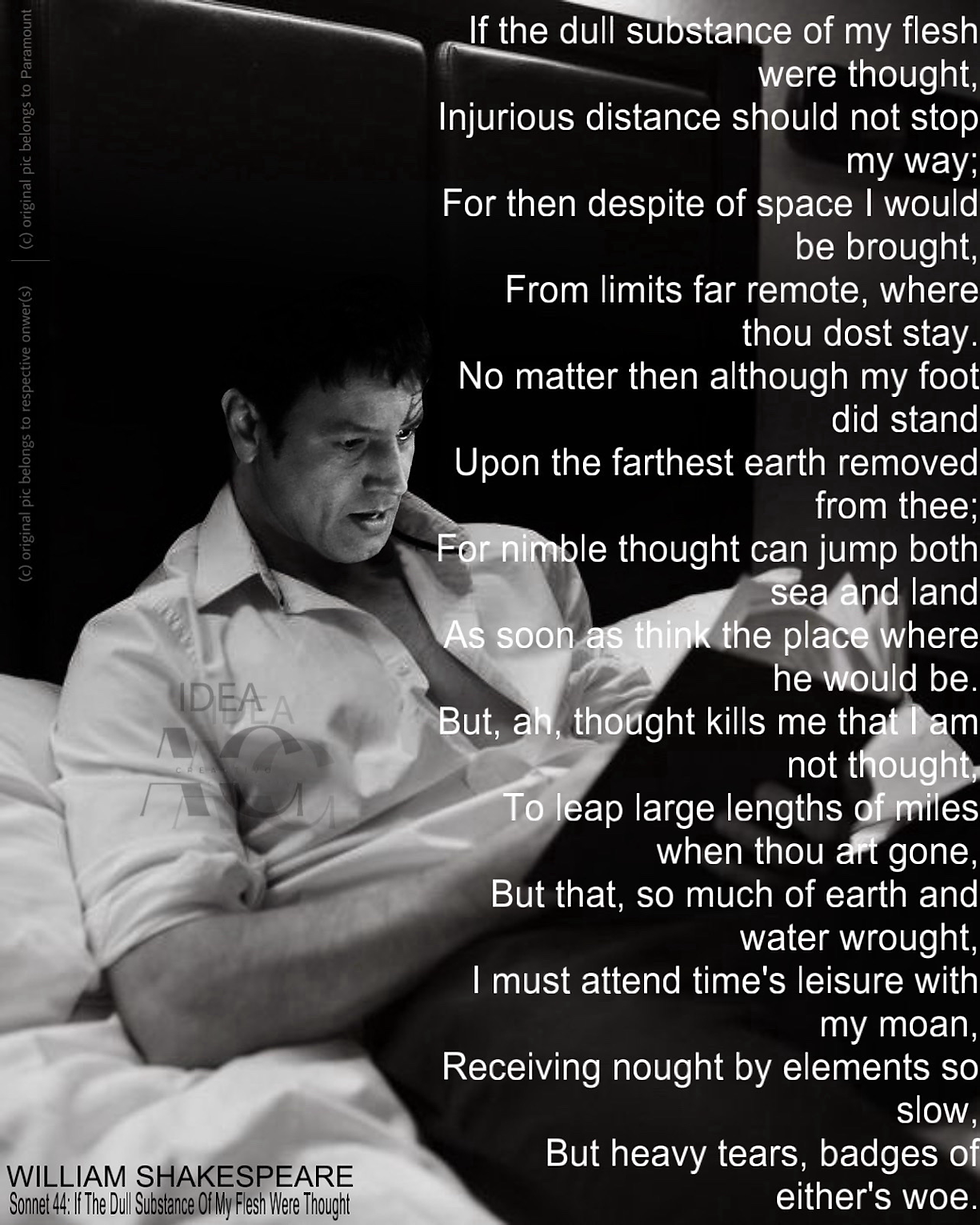Shakespeare Sonnet 44
- Alex

- May 25
- 4 min read
It's no secret, Robert Beltran loves Shakespeare and if you have the chance to ask him and talk to those who have, Robert Beltran's favorite sonnet is sonnet 44.
So, time to take a closer look:
Content and meaning
William Shakespeare's sonnet 44 is part of the so-called "Fair Youth" sequence, in which the speaker expresses his deep affection and love
In this sonnet, the speaker reflects on the physical distance intensifies his longing for his beloved.
The sonnet begins with the idea that if the speaker were only made of thought (if he were immaterial) he could overcome any distance to be with his beloved. But instead, he is bound to his physical body, made of "earth and water", two of the four classical elements that stand for heaviness. These elements prevent a quick mental journey.
The second part of the sonnet emphasizes the suffering caused by separation. Although thoughts can travel in a matter of seconds, the body is left behind. The speaker suffers from the distance, as his desire to be with his beloved is blocked by his earthly nature.
Central themes
Longing and separation: The emotional torment of physical separation is at the heart of this sonnet.
Mind vs. body: Shakespeare contrasts the boundless power of the mind with the limitations of the body.
Theory of the elements: The allusion to earth and water underlines the philosophical embedding of the poem in the scientific worldview of the time.
Linguistic means
Shakespeare uses metaphors
The antithetical structure: thoughts stand for lightness and speed. The body for heaviness and standstill. These contrasts reinforce the tension between desire and reality.
Conclusion
Sonnet 44 is an expression of the melancholy insight that although love can be spiritually boundless, it nevertheless remains bound to the physical world. The speaker suffers from the fact that he cannot bring his love to himself by sheer will. A feeling that is timeless and remains comprehensible even today.

A Deeper Look Inside
Historical context
Sonnet 44 is part of Shakespeare's famous sonnet collection, which was published in 1609. The 154 sonnets are addressed to various recipients - but primarily to a young man (in sonnets 1-126, also known as "Fair Youth") and later to a woman ("Dark Lady", from sonnet 127 onwards). The young man is described with great affection, admiration and even love - which has led many to speculate about Shakespeare's own feelings and relationships.
At the time of its creation (late 16th / early 17th century), the sonnet was a highly respected literary format, especially in the English Renaissance. It served not only to depict romantic love, but also philosophical, intellectual and moral reflection.
In sonnet 44, Shakespeare combines classical elements (such as the ancient doctrine of the four elements) with a very personal feeling: the pain of physical separation despite spiritual closeness.
The idea that "spirit" could be independent of the body comes from Platonic philosophy and was widespread in the literature of the time. The idea of unattainable closeness - being so emotionally close but physically distant - is still universally understood today.
Rhyme scheme in the original
Shakespeare's sonnets almost always follow the so-called Shakespearean sonnet pattern, which is structured as follows:
- 14 verses, divided into 3 quartets (four-line stanzas) and a concluding couplet (two-liner)
- Rhyme scheme: abab cdcd efef gg
- Meter: Usually pentameter (iambic pentameter)
Here is an example based on the first four verses of sonnet 44 in the original:
If the dull substance of my flesh were thought, (a)
Injurious distance should not stop my way; (b)
For then despite of space I would be brought (a)
From limits far remote, where thou dost stay. (b)
The rhymes thus connect every second verse, resulting in a flowing, even sound. The final couplet (verses 13-14) often brings a twist, punch line or summary of what has been said before.
Here is an overview of the stylistic devices in Shakespeare's sonnet 44, with explanations and examples
1. metaphor
Shakespeare uses metaphorical language throughout to make abstract feelings tangible:
- "If the dull substance of my flesh were thought"
→ The body is equated with "dull matter," and thoughts stand for freedom—a metaphor for the contrast between physical limitation and spiritual infinity.
- "Heavy tears" as "badges of either's woe"
→ Tears here are badges, i.e., external signs of inner suffering—a poetic paraphrase for visible pain.
2. antithesis (contrast)
Shakespeare works with strong opposites to illustrate the conflict between desire and reality:
- Thought vs. body
→ Thoughts are fast, light, and unlimited; the body, on the other hand, is heavy, slow, and bound to space and time.
- Closeness in the mind vs. separation in space
→ This juxtaposition is the emotional tragedy of the sonnet.
3. personification
Thoughts are depicted as independent beings:
- "Nimble thought can jump both sea and land."
→ Thoughts "jump" like living beings across oceans and continents—a vivid depiction of the power of imagination.
4. alliteration
Sound repetitions emphasize certain passages rhythmically and musically:
- e.g., "leap large lengths"
→ The repetition of the "l" sound reinforces the imagery of leaping great distances.
5. Classical elements (symbolism)
Shakespeare alludes to the ancient four-element theory:
- "earth and water"
→ Earth and water stand for the heavy, inert components of the body, in contrast to air and fire (which stand for spirit, movement, and passion). This lends the sonnet a philosophical depth and cultural connection to the worldview of the Renaissance.
6. irony
The speaker recognizes the paradoxical situation:
- Although thoughts could bring him to his beloved in an instant, this does not help him, for he himself is not a thought but made of body.
→ This ironic insight increases the feeling of helplessness.








Comments